新三系详解
- 格式:pps
- 大小:12.03 MB
- 文档页数:86
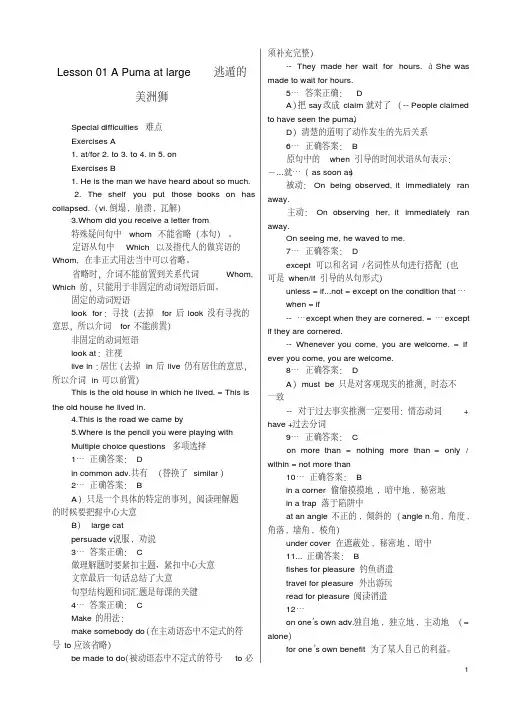
Lesson 01 A Puma at large 逃遁的美洲狮Special difficulties 难点Exercises A1. at/for2. to3. to4. in5. onExercises B1. He is the man we have heard about so much.2. The shelf you put those books on has collapsed.(vi.倒塌, 崩溃, 瓦解)3.Whom did you receive a letter from特殊疑问句中whom 不能省略(本句)。
定语从句中Which以及指代人的做宾语的Whom, 在非正式用法当中可以省略。
省略时,介词不能前置到关系代词Whom, Which前,只能用于非固定的动词短语后面。
固定的动词短语look for:寻找(去掉for后look没有寻找的意思,所以介词for不能前置)非固定的动词短语look at:注视live in:居住(去掉in后live仍有居住的意思,所以介词in可以前置)This is the old house in which he lived. = This is the old house he lived in.4.This is the road we came by5.Where is the pencil you were playing withMultiple choice questions 多项选择1…正确答案: Din common adv.共有(替换了similar)2…正确答案: BA)只是一个具体的特定的事列,阅读理解题的时候要把握中心大意B)large catpersuade v.说服, 劝说3…答案正确: C做理解题时要紧扣主题、紧扣中心大意文章最后一句话总结了大意句型结构题和词汇题是每课的关键4…答案正确: CMake的用法:make somebody do(在主动语态中不定式的符号to应该省略)be made to do(被动语态中不定式的符号to必须补充完整)-- They made her wait for hours. àShe was made to wait for hours.5…答案正确: DA)把say改成claim就对了(-- People claimed to have seen the puma.)D)清楚的道明了动作发生的先后关系6…正确答案: B原句中的when引导的时间状语从句表示:-...就…(as soon as)被动:On being observed, it immediately ran away.主动:On observing her, it immediately ran away.On seeing me, he waved to me.7…正确答案: Dexcept可以和名词/名词性从句进行搭配(也可是when/if引导的从句形式)unless = if...not = except on the condition that…when = if-- …except when they are cornered. = …except if they are cornered.-- Whenever you come, you are welcome. = If ever you come, you are welcome.8…正确答案: DA)must be只是对客观现实的推测,时态不一致-- 对于过去事实推测一定要用:情态动词+ have +过去分词9…正确答案: Con more than = nothing more than = only / within = not more than10…正确答案: Bin a corner 偷偷摸摸地, 暗中地, 秘密地in a trap 落于陷阱中at an angle 不正的, 倾斜的(angle n.角, 角度, 角落, 墙角, 棱角)under cover 在遮蔽处, 秘密地, 暗中11... 正确答案: Bfishes for pleasure 钓鱼消遣travel for pleasure 外出游玩read for pleasure 阅读消遣12…on one’s own adv.独自地, 独立地, 主动地(= alone)for one’s own benefit 为了某人自己的利益。
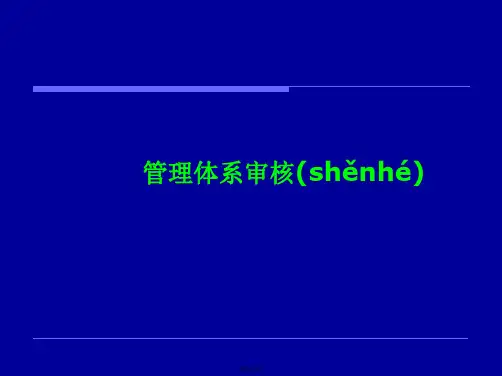

新能源汽车区别于传统车最核心的技术是“三电”,包括电驱动,电池,电控。
下面详细讲解一下三电基础知识:一、电池电池是与化学、机械工业、电子控制等相关的一个行业。
电池的关键在电芯,电芯最重要的材料便是正负极、隔膜、电解液。
正极材料广为熟知的有磷酸铁锂、钴酸锂、锰酸锂、三元、高镍三元。
动力电池是非常“年轻”的产品, 1996年通用推出EV-1采用的是铅酸电池,它是现代电动汽车架构雏形,从铅酸电池到日系混动的镍氢电池,再到现在流行的锂电池,也才20多年。
从第四批《新能源汽车推广应用推荐车型目录》新能源乘用车配置电池来看,32款车型采用了17家企业的电池,其中16家是电池厂商,另外一家是长安新能源的,这说明其它乘用车的动力电池直接外购,包括电芯、电池组与电池管理系统等。
大部分自主品牌主机厂都没有自己的电芯与电池组设计能力跨国车企,虽然没有自己的电芯,但是它们却坚持自己设计生产电池组件与管理系统,这是为了加强动力电池的核心竞争力。
与大多自主品牌的差别是,即使不采用这家的电芯,它们可以换个电芯品牌照样能够设计电池组,核心技术还是掌握在自己手里。
但是我们更关心的是动力电池,也是就新能源汽车中的能量来源,目前动力电池中,镍氢电池面临淘汰,铅酸电池全凭保有量在支撑,故目前以锂电池最为主要。
(如下图)先介绍几个重要概念能量密度方面电池肯定不如汽油,但是究竟差别多大呢?一箱50L的汽油可以大概跑600km,续航同样里程的电动车需要多少电池呢?(如下图)下表列出了四类锂电池的主要性能指标差别。
从表中可以看出,四类电池各有优劣。
那各汽车厂商究竟是凭什么选择其中某种电池呢?哪种电池又将是未来的主流呢?数码电子产品对锂电池安全性要求不高,钴酸锂电池最合适3C领域,特斯拉敢于使用此类电池也是未来得到超强的续航能力,但是同时其安全性能要打些折扣。
锰酸锂电池因其不偏不倚的特征赢得动力电池最大的市场占有率,虽然其能量密度不如钴酸锂和三元锂,但其他综合性能相当出色。

新能源汽车区别于传统车最核心的技术是“三电”,包括电驱动,电池,电控。
下面详细讲解一下三电基础知识:一、电池电池是与化学、机械工业、电子控制等相关的一个行业。
电池的关键在电芯,电芯最重要的材料便是正负极、隔膜、电解液。
正极材料广为熟知的有磷酸铁锂、钴酸锂、锰酸锂、三元、高镍三元。
动力电池是非常“年轻”的产品, 1996年通用推出EV-1采用的是铅酸电池,它是现代电动汽车架构雏形,从铅酸电池到日系混动的镍氢电池,再到现在流行的锂电池,也才20多年。
从第四批《新能源汽车推广应用推荐车型目录》新能源乘用车配置电池来看,32款车型采用了17家企业的电池,其中16家是电池厂商,另外一家是长安新能源的,这说明其它乘用车的动力电池直接外购,包括电芯、电池组与电池管理系统等。
大部分自主品牌主机厂都没有自己的电芯与电池组设计能力跨国车企,虽然没有自己的电芯,但是它们却坚持自己设计生产电池组件与管理系统,这是为了加强动力电池的核心竞争力。
与大多自主品牌的差别是,即使不采用这家的电芯,它们可以换个电芯品牌照样能够设计电池组,核心技术还是掌握在自己手里。
但是我们更关心的是动力电池,也是就新能源汽车中的能量来源,目前动力电池中,镍氢电池面临淘汰,铅酸电池全凭保有量在支撑,故目前以锂电池最为主要。
(如下图)先介绍几个重要概念能量密度方面电池肯定不如汽油,但是究竟差别多大呢?一箱50L的汽油可以大概跑600km,续航同样里程的电动车需要多少电池呢?(如下图)下表列出了四类锂电池的主要性能指标差别。
从表中可以看出,四类电池各有优劣。
那各汽车厂商究竟是凭什么选择其中某种电池呢?哪种电池又将是未来的主流呢?数码电子产品对锂电池安全性要求不高,钴酸锂电池最合适3C领域,特斯拉敢于使用此类电池也是未来得到超强的续航能力,但是同时其安全性能要打些折扣。
锰酸锂电池因其不偏不倚的特征赢得动力电池最大的市场占有率,虽然其能量密度不如钴酸锂和三元锂,但其他综合性能相当出色。

天文学基础知识点详解在我们日常生活中,我们总是被广袤的宇宙所吸引。
我们想要了解科学家们是如何研究天文学的,以及他们探索宇宙的奥秘。
在本文中,我们将详细讨论几个天文学的基础知识点,以帮助我们更好地理解宇宙的运行。
一、太阳系的结构太阳系是由太阳、行星、卫星、小行星带和彗星带等组成的巨大物质系统。
太阳是太阳系的中心,围绕太阳运行的是包括水星、金星、地球和火星在内的行星。
而行星的卫星也围绕行星自转。
此外,太阳系中还有一片较为稀疏的小天体区域,称为小行星带,以及远离太阳的彗星带,这些小行星和彗星的轨道也受到太阳的引力影响。
二、恒星与星系恒星是宇宙中的基本构建单元,由巨大的气体核心和被引力束缚在周围的等离子体组成。
恒星可以通过测量其亮度、颜色和光谱进行分类,其中最常见的恒星类型包括红矮星、黄矮星和蓝巨星。
恒星之间以银河系等大型星系的形式组织在一起。
星系是由庞大数量的恒星、行星、恒星附近的气体云和黑洞组成的。
银河系是我们所在的星系,它包含大约2000亿颗星星。
三、宇宙膨胀宇宙膨胀是现代天文学的一个重要理论,它基于观测到的宇宙中的星系在互相远离。
根据大爆炸理论,宇宙是在约137亿年前从一个极端高温高密度的初始状态膨胀而来的。
而事实上,宇宙膨胀并不意味着事物扩张到了宇宙中的某个地方,而是空间本身的膨胀。
四、黑洞和中子星黑洞是宇宙中最神秘的物体之一,它是一种密度极高、引力极强的天体。
黑洞的引力场非常强大,甚至连光都无法逃离,因此我们无法直接观测到黑洞。
中子星是由大质量恒星爆炸后残留下来的,它的质量非常庞大,但体积却非常小。
中子星由中子组成,这些中子被压缩得非常紧密,以至于它们之间的关系能够抵消自身引力。
五、星际物质星际物质是宇宙中广泛存在的物质,由气体和微尘组成。
这些星际物质形成了星际云,它们是新星形成的原材料。
星际云具有不同的密度和温度,当其中的一些地区足够密集时,就会形成新的恒星。
总结:天文学是人类对宇宙和天体的研究。

宝马新3系长轴版官图详解轴距加长110mm∙易车网∙2012年04月06日05:00∙来源:易车网∙作者:毕远浩∙图片新闻【易车网图解新车】昨天,我给读者简单介绍了华晨宝马全新BMW 3系长轴距版(以下简称新3系L)官图及相关车型信息(想回顾?点击这里>>>),为了让读者更系统地了解这款专为中国市场设计研发的加长轴距车型,我在综合官方信息以及对比标准轴距版新3系的设计后,做了以下这篇图解文章。
其实,华晨宝马全新BMW 3系长轴距版并非仅仅是加长了轴距,更多专属设计也与标准轴距版3系有着较大的区别,他们到底不同在哪?看完本文您就会明白:较早前我同事已经对全新BMW 3系做过一次官图详解,点击下图链接查看详细:外观:轴距拉长110mm 整车线条经重新优化新3系L车身尺寸分别为长4734mm、宽1811mm、高1455mm,轴距达到了2920mm,不仅全面超越标准轴距版新3系,面对同级竞争车型也同样有着较大的优势。
(新3系L、标准轴距新3系、新奥迪A4L、新奔驰C级四款车型参数对比如下表)与标准轴距版新3系相比,新3系L最大特点无疑是它的加长设计。
新3系L是在第六代宝马新3系轿车基础上,对车长和轴距同时增加110mm设计而成。
当然了,除了车身加长以外,新3系L也有不少变化与标准轴距版车型不同,但不变的是它的车身依然采用了大部分新宝马3系轿车固有的特征元素,重点可体现在短前后悬,长发动机舱等方面,并同时保留了优雅和豪华的气质。
细节方面,新3系L同样采用了标准轴距版新3系的双肾形中网格栅及V形发动机舱盖设计前脸,依然保留了大灯与双肾形格栅过渡的水平小版块,凸显整车前脸的宽度,这个设计我最初看觉得很不可思议,看多了觉得也不会很难看,至于消费者是否喜欢,那就见仁见智了。
根据335Li和328Li配置不同,前保险杠下方雾灯的装饰条也有不同,335Li采用的是单条L型合金金属条装饰,而328Li则是用的双横辐平行镀铬条装饰。
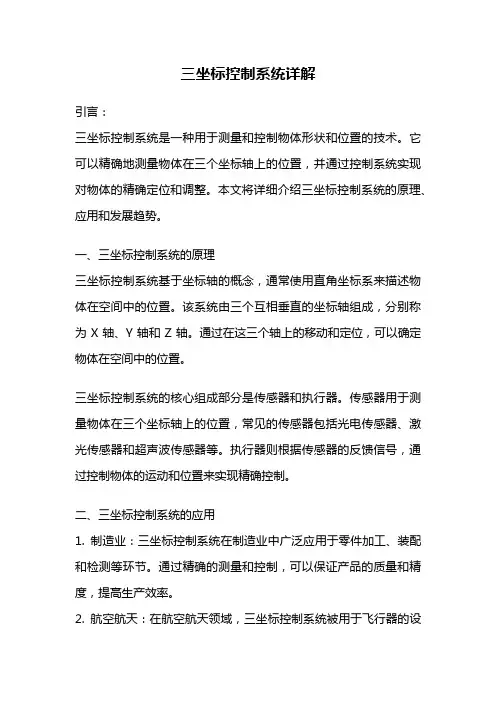
三坐标控制系统详解引言:三坐标控制系统是一种用于测量和控制物体形状和位置的技术。
它可以精确地测量物体在三个坐标轴上的位置,并通过控制系统实现对物体的精确定位和调整。
本文将详细介绍三坐标控制系统的原理、应用和发展趋势。
一、三坐标控制系统的原理三坐标控制系统基于坐标轴的概念,通常使用直角坐标系来描述物体在空间中的位置。
该系统由三个互相垂直的坐标轴组成,分别称为X轴、Y轴和Z轴。
通过在这三个轴上的移动和定位,可以确定物体在空间中的位置。
三坐标控制系统的核心组成部分是传感器和执行器。
传感器用于测量物体在三个坐标轴上的位置,常见的传感器包括光电传感器、激光传感器和超声波传感器等。
执行器则根据传感器的反馈信号,通过控制物体的运动和位置来实现精确控制。
二、三坐标控制系统的应用1. 制造业:三坐标控制系统在制造业中广泛应用于零件加工、装配和检测等环节。
通过精确的测量和控制,可以保证产品的质量和精度,提高生产效率。
2. 航空航天:在航空航天领域,三坐标控制系统被用于飞行器的设计、制造和测试。
它可以确保飞行器的各个部件的精确配合和定位,提高航空器的性能和安全性。
3. 医疗器械:在医疗器械制造过程中,三坐标控制系统可以用于精确测量和调整器械的尺寸和形状,保证其符合医疗标准和要求。
4. 科学研究:在科学研究中,三坐标控制系统可以用于实验室仪器的校准和测量。
它可以提供精确的数据支持,为科学家的研究工作提供准确可靠的依据。
三、三坐标控制系统的发展趋势随着科技的不断进步,三坐标控制系统也在不断演进和改进。
以下是三坐标控制系统的一些发展趋势:1. 精度提升:随着制造技术的进步,三坐标控制系统的测量精度不断提高。
传感器和执行器的性能得到了提升,能够实现更加精细的测量和控制。
2. 自动化应用:自动化是当前工业发展的一个重要趋势,三坐标控制系统也在向自动化方向发展。
通过与计算机和机器人技术的结合,实现对物体位置和形状的自动测量和调整。
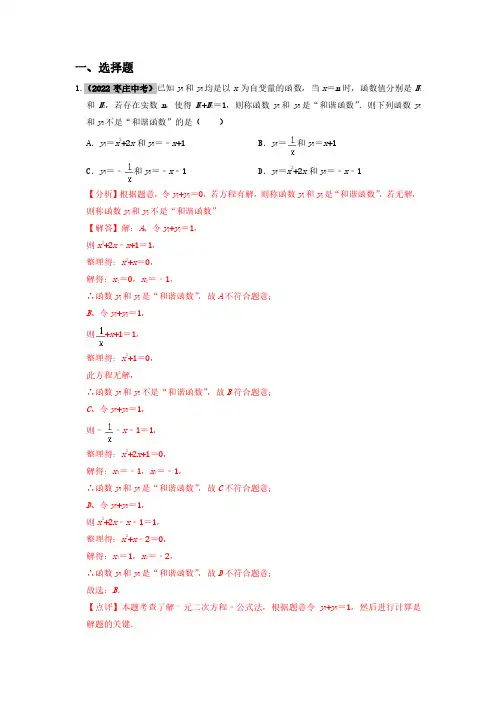
一、选择题1.(2022枣庄中考)已知y1和y2均是以x为自变量的函数,当x=n时,函数值分别是N1和N2,若存在实数n,使得N1+N2=1,则称函数y1和y2是“和谐函数”.则下列函数y1和y2不是“和谐函数”的是()A.y1=x2+2x和y2=﹣x+1 B.y1=和y2=x+1C.y1=﹣和y2=﹣x﹣1 D.y1=x2+2x和y2=﹣x﹣1【分析】根据题意,令y1+y2=0,若方程有解,则称函数y1和y2是“和谐函数”,若无解,则称函数y1和y2不是“和谐函数”【解答】解:A、令y1+y2=1,则x2+2x﹣x+1=1,整理得:x2+x=0,解得:x1=0,x2=﹣1,∴函数y1和y2是“和谐函数”,故A不符合题意;B、令y1+y2=1,则+x+1=1,整理得:x2+1=0,此方程无解,∴函数y1和y2不是“和谐函数”,故B符合题意;C、令y1+y2=1,则﹣﹣x﹣1=1,整理得:x2+2x+1=0,解得:x1=﹣1,x2=﹣1,∴函数y1和y2是“和谐函数”,故C不符合题意;D、令y1+y2=1,则x2+2x﹣x﹣1=1,整理得:x2+x﹣2=0,解得:x1=1,x2=﹣2,∴函数y1和y2是“和谐函数”,故D不符合题意;故选:B.【点评】本题考查了解一元二次方程﹣公式法,根据题意令y1+y2=1,然后进行计算是解题的关键.2. (2022娄底中考) 若10x N =,则称x 是以10为底N 的对数.记作:lg x N =.例如:210100=,则2lg100=;0101=,则0lg1=.对数运算满足:当0M >,0N >时,()lg lg lg M N MN +=,例如:lg3lg5lg15+=,则()2lg5lg5lg 2lg 2+⨯+的值为( )A. 5B. 2C. 1D. 0【答案】C 【解析】【分析】通过阅读自定义运算规则:()lg lg lg M N MN +=,再得到lg101,= 再通过提取公因式后逐步进行运算即可得到答案. 【详解】解:Q ()lg lg lg M N MN +=,∴ ()2lg5lg5lg 2lg 2+⨯+()lg5lg5lg 2lg 2=++lg5lg10lg 2=+g lg5lg 2=+ lg10=1.=故选C【点睛】本题考查的是自定义运算,理解题意,弄懂自定义的运算法则是解本题的关键. 3. (2022常德中考) 我们发现:633+=,6633++=,66633+++=,…,6666633n ++++++=L 144444424444443个根号,一般地,对于正整数a,b ,如果满足n b b b b b a a ++++++=L 14444444244444443个根号时,称(),a b 为一组完美方根数对.如上面()3,6是一组完美方根数对.则下面4个结论:①()4,12是完美方根数对;②()9,91是完美方根数对;③若(),380a 是完美方根数对,则20a =;④若(),x y 是完美方根数对,则点(),P x y 在抛物线2y x x =-上.其中正确的结论有( ) A. 1个 B. 2个C. 3个D. 4个【答案】C 【解析】【分析】根据定义逐项分析判断即可. 【详解】解:1244+=Q ,∴()4,12是完美方根数对;故①正确;Q91910+=9≠∴()9,91不是完美方根数对;故②不正确;若(),380a 380a a += 即2380a a =+ 解得20a =或19a =−a Q 是正整数则20a = 故③正确;若(),x y y x x +=2y x x ∴+=,即2y x x =- 故④正确 故选C【点睛】本题考查了求算术平方根,解一元二次方程,二次函数的定义,理解定义是解题的关键.4. (2022重庆中考A 卷)对多项式x y z m n −−−−任意加括号后仍然只含减法运算并将所得式子化简,称之为“加算操作”,例如:()()x y z m n x y z m n −−−−=−−++,()x y z m n x y z m n −−−−=−−+−,…,给出下列说法:①至少存在一种“加算操作”,使其结果与原多项式相等; ②不存在任何“加算操作”,使其结果与原多项式之和0;③所有的“加算操作”共有8种不同的结果. 以上说法中正确的个数为( ) A. 0 B. 1C. 2D. 3【答案】D 【解析】【分析】给x y −添加括号,即可判断①说法是否正确;根据无论如何添加括号,无法使得x 的符号为负号,即可判断②说法是否正确;列举出所有情况即可判断③说法是否正确.为【详解】解:∵()x y z m n x y z m n −−−−=−−−− ∴①说法正确∵0x y z m n x y z m n −−−−−++++= 又∵无论如何添加括号,无法使得x 的符号为负号 ∴②说法正确∵当括号中有两个字母,共有4种情况,分别是()x y z m n −−−−、()x y z m n −−−−、()x y z m n −−−−、()x y z m n −−−−;当括号中有三个字母,共有3种情况,分别()x y z m n −−−−、()x y z m n −−−−、()x y z m n −−−−;当括号中有四个字母,共有1种情况,()x y z m n −−−− ∴共有8种情况 ∴③说法正确 ∴正确的个数为3 故选D .【点睛】本题考查了新定义运算,认真阅读,理解题意是解答此题的关键.二、填空题1. (2022宁波中考) 定义一种新运算:对于任意的非零实数a ,b ,11ba b a ⊗=+.若21(1)++⊗=x x x x,则x 的值为___________. 【答案】12−##0.5− 【解析】【分析】根据新定义可得221(1)x x x x x ++⊗=+,由此建立方程22121x x x x x++=+解方程即可.【详解】解:∵11ba b a ⊗=+, ∴()211121(1)11x x x x x x x x x x x ++++⊗=+==+++, 又∵21(1)++⊗=x x x x, ∴22121x x x x x++=+, 是∴()()()221210x xx x x ++−+=,∴()()2210x x x x +−+=,∴()2210xx +=,∵21(1)++⊗=x x x x即0x ≠, ∴210x +=, 解得12x =−,经检验12x =−是方程22121x x x x x++=+的解,故答案为:12−. 【点睛】本题主要考查了新定义下的实数运算,解分式方程,正确理解题意得到关于x 的方程是解题的关键.2.(2022内江中考)(5分)对于非零实数a ,b ,规定a ⊕b =﹣.若(2x ﹣1)⊕2=1,则x 的值为.【分析】利用新规定对计算的式子变形,解分式方程即可求得结论. 【解答】解:由题意得:=1,解得:x =.经检验,x =是原方程的根,∴x =.故答案为:. 【点评】本题主要考查了解分式方程,本题是新定义型题目,准确理解新规定并熟练应用是解题的关键.3. (2022荆州中考)规定:两个函数1y ,2y 的图象关于y 轴对称,则称这两个函数互为“Y 函数”.例如:函数122y x =+与222y x =−+的图象关于y 轴对称,则这两个函数互为“Y 函数”.若函数()2213y kx k x k =+−+−(k 为常数)的“Y 函数”图象与x 轴只有一个交点,则其“Y 函数”的解析式为______. 【答案】23y x =−或244y x x =−+− 【解析】【分析】分两种情况,根据关于y 轴对称的图形的对称点的坐标特点,即可求得. 【详解】解:Q 函数()2213y kx k x k =+−+−(k 为常数)的“Y 函数”图象与x 轴只有一个交点,∴函数()2213y kx k x k =+−+−(k 为常数)的图象与x 轴也只有一个交点,当k =0时,函数解析为23y x =−−,它“Y 函数”解析式为23y x =−,它们的图象与x 轴只有一个交点,当0k ≠时,此函数是二次函数,Q 它们的图象与x 轴都只有一个交点,∴它们的顶点分别在x 轴上,()()2432104k k k k−−−⎡⎤⎣⎦∴=,得10k k+=, 故k +1=0,解得k =-1,故原函数的解析式为244y x x =−−−,故它的“Y 函数”解析式为244y x x =−+−,故答案为:23y x =−或244y x x =−+−.【点睛】本题考查了新定义,二次函数图象与x 轴的交点问题,坐标与图形变换-轴对称,求一次函数及二次函数的解析式,理解题意和采用分类讨论的思想是解决本题的关键. 4. (2022苏州中考)定义:一个三角形的一边长是另一边长的2倍,这样的三角形叫做“倍长三角形”.若等腰△ABC 是“倍长三角形”,底边BC 的长为3,则腰AB 的长为______. 【答案】6 【解析】【分析】分类讨论:AB =AC =2BC 或BC =2AB =2AC ,然后根据三角形三边关系即可得出结果. 【详解】解:∵△ABC 是等腰三角形,底边BC =3 ∴AB =AC当AB =AC =2BC 时,△ABC 是“倍长三角形”;当BC =2AB =2AC 时,AB +AC =BC ,根据三角形三边关系,此时A 、B 、C 不构成三角形,不符合题意;所以当等腰△ABC 是“倍长三角形”,底边BC 的长为3,则腰AB 的长为6. 故答案为6.的【点睛】本题考查等腰三角形,三角形的三边关系,涉及分类讨论思想,结合三角形三边关系,灵活运用分类讨论思想是解题的关键.5. (2022绥化中考)定义一种运算;sin()sin cos cos sin αβαβαβ+=+,sin()sin cos cos sin αβαβαβ−=−.例如:当45α=︒,30β=︒时,()sin 4530︒+︒=232162222++=,则sin15︒的值为_______. 【答案】624− 【解析】【分析】根据sin()sin cos cos sin αβαβαβ−=−代入进行计算即可. 【详解】解:sin15sin(4530)︒=︒−︒ =sin 45cos30cos 45sin30︒︒︒︒− =23212222⨯−⨯ =6244−=624. 故答案为:624. 【点睛】此题考查了公式的变化,以及锐角三角函数值的计算,掌握公式的转化是解题的关键.6. (2022上海中考)定义:有一个圆分别和一个三角形的三条边各有两个交点,截得的三条弦相等,我们把这个圆叫作“等弦圆”,现在有一个斜边长为2的等腰直角三角形,当等弦圆最大时,这个圆的半径为_____. 【答案】2222− 【解析】【分析】如图,当等弦圆O 最大时,则O e 经过等腰直角三角形的直角顶点C ,连接CO 交AB 于F ,连接OE ,DK ,再证明DK 经过圆心,CF AB ⊥,分别求解AC ,BC ,CF , 设O e 的半径为,r 再分别表示,,,EF OF OE 再利用勾股定理求解半径r 即可.【详解】解:如图,当等弦圆O 最大时,则O e 经过等腰直角三角形的直角顶点C ,连接CO 交AB 于F ,连接OE ,DK ,,90,CD CK EQ ACB ==??Q90,COD COK\??? DK 过圆心O ,CF AB ⊥,,90,2,AC BC ACB AB =??Q12,1,2AC BC AF BF CF AB \===== 设O e 的半径为,r∴222,1,,CD r r r EQ OF r OE r =+==-=,CF AB ⊥Q2,2EF QF r \== ()22221,2r r r 骣琪\=-+琪桫整理得:2420,r r -+= 解得:1222,22,r r ==-,OC CF <Q22r \=不符合题意,舍去,∴当等弦圆最大时,这个圆的半径为2 2. 故答案为:22【点睛】本题考查的是等腰直角三角形的性质,直角三角形斜边上的中线的性质,弦,弧,圆心角之间的关系,圆周角定理的应用,勾股定理的应用,一元二次方程的解法,掌握以上知识是解本题的关键.三、解答题1. (2022兰州中考) 在平面直角坐标系中,(),P a b 是第一象限内一点,给出如下定义:1ak b =和2k b a=两个值中的最大值叫做点P 的“倾斜系数”k .(1)求点()6,2P 的“倾斜系数”k 的值;(2)①若点(),P a b 的“倾斜系数”2k =,请写出a 和b 的数量关系,并说明理由; ②若点(),P a b 的“倾斜系数”2k =,且3a b +=,求OP 的长;(3)如图,边长为2的正方形ABCD 沿直线AC :y x =运动,(),P a b 是正方形ABCD 上任意一点,且点P 的“倾斜系数”3k <a 的取值范围. 【答案】(1)3 (2)①a -2b 或b =2a ,②OP 5 (33a 3【解析】【分析】(1)直接由“倾斜系数”定义求解即可; (2)①由点(),P a b 的“倾斜系数”2k =,由ab =2或b a=2求解即可; ②由a =2b 或b =2a ,又因a +b =3,求出a 、b 值,即可得点P 坐标,从而由勾股定理可求解; (3)当点P 与点D 重合时,且k 3a 有最小临界值,此时,ba3则23a a+=,求得a 3;当点P 与B 点重合,且k 3a 有最大临界值,此时,3ab=,则32aa =−求得:a 33k <时,a 的取值范围. 【小问1详解】 解:由题意,得632=,2163=, ∵3>13, ∴点()6,2P 的“倾斜系数”k =3;【小问2详解】 解:①a =2b 或b =2a ,∵点(),P a b 的“倾斜系数”2k =, 当ab=2时,则a =2b ; 当ba=2时,则b =2a , ∴a =2b 或b =2a ;②∵(),P a b 的“倾斜系数”2k =, 当ab=2时,则a =2b ∵3a b +=, ∴2b +b =3, ∴b =1, ∴a =2, ∴P (2,1),∴OP 22215+=; 当ba=2时,则b =2a , ∵3a b +=, ∴a +2a =3, ∴a =1, ∴b =2, ∴P (1,2)∴OP 22125+= 综上,OP 5 【小问3详解】解:由题意知,当点P 与点D 重合时,且k 3a 有最小临界值,如图,连接OD ,延长DA 交x 轴于E ,。

专题04 考纲详解板块三——文化生活专题9 文化与生活【考纲原文】1.文化与生活(1)文化与社会文化的内涵与特点文化的形式文化的社会作用文化与经济、政治的关系文化与综合国力(2)文化对人的影响文化对人影响的表现文化对人影响的特点丰富精神世界,促进全面发展【常考视角】视角1 依托小岗村的改革成果、国家颁布的关于农业改革发展的文件,考查文化的作用【例题】(2024·新课标Ⅰ文综)阅读材料,完成下列要求。
2024年是改革开放40周年。
我国改革起先于农村,安徽省凤阳县小岗村是我国农村改革的主要发源地。
我国农村改革始终是在党的领导下进行的。
材料一1978年冬,小岗村的18户村民以“敢为天下先”的精神,在一纸大包干的“隐私契约”上按下鲜红的手印,拉开了中国农村改革的序幕。
改革犹如释放了魔力,次年,小岗村迎来大丰收,粮食总产达13.3万斤,一举结束20余年吃国家救济粮的历史,并首次归还国家贷款800元。
进入新时代,小岗村大力推动土地“三权分置”改革,完成土地承包经营权确权登记颁证工作;成立集体资产股份合作社并发放股权证,实现了村民“户户包田”到“人人持股”的转变。
2024年,小岗村集体收入突破820万元,农村人均收入比2012年增长70%以上。
材料二为发展农村生产力,满意广阔农夫摆脱贫困、过上富有生活的期盼,党中心先后出台了一系列关于农业改革发展的文件,如1982年发布《全国农村工作会议纪要》,明确确定“包干到户”等形式的责任制的社会主义性质;1991年颁发《中共中心关于进一步加强农业和农村工作的确定》,把以家庭联产承包经营为主的责任制和统分结合的双层经营体制确立为我国农村的一项基本经营制度;2024年制定《关于完善农村土地全部权承包权经营权分置方法的看法》,推动“三权分置”改革;2024年出台《中共中心国务院关于实施乡村振兴战略的看法》,指导农村改革发展不断深化。
(2)运用文化生活的有关学问并结合材料二,分析先进文化在推动我国农村改革发展中的作用。
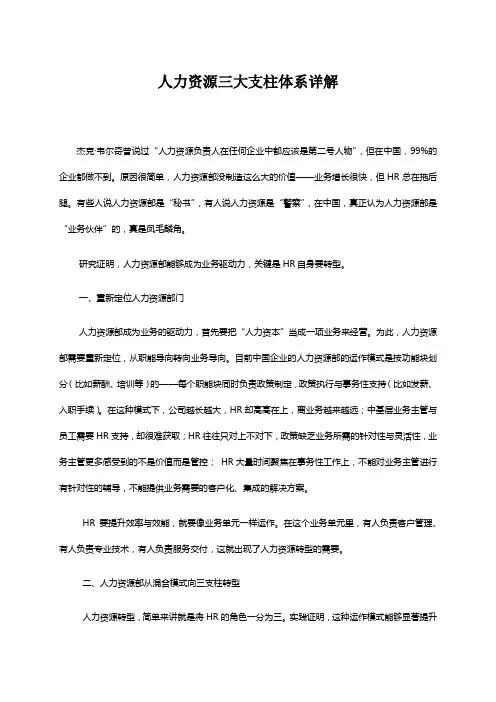
人力资源三大支柱体系详解杰克·韦尔奇曾说过“人力资源负责人在任何企业中都应该是第二号人物”,但在中国,99%的企业都做不到。
原因很简单,人力资源部没制造这么大的价值——业务增长很快,但HR总在拖后腿。
有些人说人力资源部是“秘书”,有人说人力资源是“警察”,在中国,真正认为人力资源部是“业务伙伴”的,真是凤毛麟角。
研究证明,人力资源部能够成为业务驱动力,关键是HR自身要转型。
一、重新定位人力资源部门人力资源部成为业务的驱动力,首先要把“人力资本”当成一项业务来经营。
为此,人力资源部需要重新定位,从职能导向转向业务导向。
目前中国企业的人力资源部的运作模式是按功能块划分(比如薪酬、培训等)的——每个职能块同时负责政策制定,政策执行与事务性支持(比如发薪、入职手续)。
在这种模式下,公司越长越大,HR却高高在上,离业务越来越远;中基层业务主管与员工需要HR支持,却很难获取;HR往往只对上不对下,政策缺乏业务所需的针对性与灵活性,业务主管更多感受到的不是价值而是管控;HR大量时间聚焦在事务性工作上,不能对业务主管进行有针对性的辅导,不能提供业务需要的客户化、集成的解决方案。
HR要提升效率与效能,就要像业务单元一样运作。
在这个业务单元里,有人负责客户管理、有人负责专业技术,有人负责服务交付,这就出现了人力资源转型的需要。
二、人力资源部从混合模式向三支柱转型人力资源转型,简单来讲就是将HR的角色一分为三。
实践证明,这种运作模式能够显著提升HR的效率与效能,这就是在领先公司中常见的HR三支柱模式,见下图:像业务部门一样运作,人力资源部首先要回答的是我的客户是谁,需求是什么?从上图来看,人力资源部门通过满足内部客户(业务部门)的需求,从而间接实现外部客户需求的满足。
借用营销的客户细分理论,HR能够把自己目标客户分成三类:1. 高层管理人员:他们的需求要紧围绕在战略执行所需的组织、人才、文化及变革管理等方面的支持;2. 中层管理人员:他们的需求要紧围绕在人员管理所需的咨询、辅导及工具、数据支持;3. 员工:他们的需求要紧围绕在解答政策方面的疑问,并提供便利的服务,比如劳动合同,入职手续、薪资发放等。

第三章热力学定律1.功、热和内能的改变................................................................................................ - 1 -2. 热力学第一定律....................................................................................................... - 10 -3. 能量守恒定律........................................................................................................... - 10 -4. 热力学第二定律....................................................................................................... - 18 -章末复习提高................................................................................................................ - 28 -1.功、热和内能的改变一、功和内能1.焦耳的实验(1)绝热过程:系统只由于外界对它做功而与外界交换能量,它不从外界吸热,也不向外界放热。
(2)代表性实验①重物下落带动叶片搅拌容器中的水,引起水温上升;②通过电流的热效应给水加热。
(3)实验结论:要使系统状态通过绝热过程发生变化,做功的数量只由过程始末两个状态决定,而与做功的方式无关。
2.功和内能(1)内能:任何一个热力学系统都必定存在一个只依赖于系统自身状态的物理量,这个物理量在两个状态间的差别与外界在绝热过程中对系统所做的功相联系。
1(2(3(4(5(②③④ C.①④ D.①②③④坐标系基础>题型:坐标系内坐标的特征6(街与大道的十字路口,点表示街与大道的十字路口,如果用表示由到的一条路径,那么你能用同样的方式写出由到7(8(9(10(∵,轴,∴点在直线上,由垂线段最短,可得,线段的最小值为,此时点综合类问题>最短路径问题>题型:垂线段最短11(12(13(14(人玩的一盘棋,若白的位置是,黑的位置是∵白的位置是,黑的位置是15(>平面直角坐标系>坐标系综合>.如图所示:,即为所求.级16(17(点坐标的对称规律:关于哪个轴对称,哪个值不变,另一个变成相反数.18(19(20(21(22(四点的位置,并顺次连接、、、;;(直接写出结果)>平面直角坐标系>坐标系综合>题型:坐标系中的平移四边形的面积是:故答案为:.B. C. D.(分)如图,在直角坐标系中,、两点的坐标分别为23..题型:坐标系内坐标的特征24(是平面内一动点,且的面积为25已知:26(27(.28(函数>平面直角坐标系D.(29点的竖线为对称轴,以正方形的竖对称轴分别做对称各一个格点三角形.(分)在平面直角坐标系中,一个智能机器人接到如下命令:从原点出发,按向右,向上,向右,向下的方向依次不断移动,每次移动,其行走路线如图所示,第次移动到,第次移动,…,第次移动到3031(32(33(。
新能源汽车三电系统详解(图文并茂)编辑整理:尊敬的读者朋友们:这里是精品文档编辑中心,本文档内容是由我和我的同事精心编辑整理后发布的,发布之前我们对文中内容进行仔细校对,但是难免会有疏漏的地方,但是任然希望(新能源汽车三电系统详解(图文并茂))的内容能够给您的工作和学习带来便利。
同时也真诚的希望收到您的建议和反馈,这将是我们进步的源泉,前进的动力。
本文可编辑可修改,如果觉得对您有帮助请收藏以便随时查阅,最后祝您生活愉快业绩进步,以下为新能源汽车三电系统详解(图文并茂)的全部内容。
新能源汽车区别于传统车最核心的技术是“三电”,包括电驱动,电池,电控。
下面详细讲解一下三电基础知识:一、电池电池是与化学、机械工业、电子控制等相关的一个行业。
电池的关键在电芯,电芯最重要的材料便是正负极、隔膜、电解液。
正极材料广为熟知的有磷酸铁锂、钴酸锂、锰酸锂、三元、高镍三元。
动力电池是非常“年轻”的产品,1996年通用推出EV-1采用的是铅酸电池,它是现代电动汽车架构雏形,从铅酸电池到日系混动的镍氢电池,再到现在流行的锂电池,也才20多年.从第四批《新能源汽车推广应用推荐车型目录》新能源乘用车配置电池来看,32款车型采用了17家企业的电池,其中16家是电池厂商,另外一家是长安新能源的,这说明其它乘用车的动力电池直接外购,包括电芯、电池组与电池管理系统等。
大部分自主品牌主机厂都没有自己的电芯与电池组设计能力跨国车企,虽然没有自己的电芯,但是它们却坚持自己设计生产电池组件与管理系统,这是为了加强动力电池的核心竞争力。
与大多自主品牌的差别是,即使不采用这家的电芯,它们可以换个电芯品牌照样能够设计电池组,核心技术还是掌握在自己手里。
但是我们更关心的是动力电池,也是就新能源汽车中的能量来源,目前动力电池中,镍氢电池面临淘汰,铅酸电池全凭保有量在支撑,故目前以锂电池最为主要。
(如下图)先介绍几个重要概念能量密度方面电池肯定不如汽油,但是究竟差别多大呢?一箱50L的汽油可以大概跑600km,续航同样里程的电动车需要多少电池呢?(如下图)下表列出了四类锂电池的主要性能指标差别。
专题2.6 有理数的混合运算专项训练(40题)【北师大版】考卷信息:本套训练卷共40题,题型针对性较高,覆盖面广,选题有深度,可加强学生对有理数混合运算的理解!1.(2023春·河北唐山·七年级统考期末)计算:(512−59)÷(−536)【答案】1【分析】先将除法变成乘法,再去括号运算即可.【详解】解:(512−59)÷(−536)=(512−59)×(−365) =512×(−365)−59×(−365) =−3+4=1.【点睛】本题主要考查有理数的混合运算,掌握有理数的混合运算的法则是解题的关键.2.(2023春·辽宁大连·七年级统考期末)计算:(−10)+3[(−4)2÷(−8)−(1+32)×2].【答案】−1022【分析】按照先计算乘方,再计算乘除法,最后计算加减法,有括号先计算括号的运算顺序求解即可.【详解】解:原式=−1000+[16÷(−8)−(1+9)×2]=−1000+(−2−10×2)=−1000−2−20=−1022.【点睛】本题主要考查了含乘方的有理数混合计算,熟知相关计算法则是解题的关键.3.(2023春·上海浦东新·六年级上海市民办新竹园中学校考期中)计算:[(−1)2018+(1−12)×13]+(−32+2) 【答案】−556【分析】先计算有理数的乘方,再计算括号内的减法、有理数的乘法,然后计算有理数的减法即可.【详解】解:原式=(1+12×13)+(−9+2)=(1+16)−7 =116−7 =−556【点睛】本题考查了含乘方的有理数混合运算,熟记有理数的运算法则是解题关键.4.(2023春·安徽安庆·七年级统考期末)计算:−16−(0.5−13)÷16×[−2−(−3)3]−|23−32|. 【答案】−27【分析】先计算括号内的,并要先计算乘方,再计算乘除,最后计算加减即可.【详解】解:原式=−1−16×6×[−2−(−27)]−|8−9| =−1−25−1=−27.【点睛】本题考查有理数混合运算,熟练掌握有理数混合运算法则是解题的关键.5.(2023春·河南南阳·七年级统考期中)计算: (12−1)×(13−1)×(13−1)×...×(12022−1) .【答案】−12022【分析】计算出每个括号内的减法运算,观察相邻两个因数的分子分母,第一项的分母可以与第二项的分子约分,第二项的分母可以与第三项的分子约分,以此类推,化简式子计算出最终结果.【详解】解:(12−1)×(13−1)×(14−1)×...×(12022−1),=(−12)×(−23)×(−34)×...×(−20212022),=−12022.【点睛】本题考查了有理数的复杂运算,解决此题的关键是观察式子的一般规律子再利用简便运算计算结果.6.(2023春·河南南阳·七年级统考期中)计算(1)(−15)×(18−13)÷(−124); (2)−12020×[4−(−3)2]+3÷|−34|;【答案】(1)−1(2)9【分析】(1)按照有理数四则混合运算法则计算即可;(2)先算乘方、然后按照有理数四则混合运算法则计算即可.【详解】(1)解:(−15)×(18−13)÷(−124) =−15×(324−824)×(−24) =−15×(−524)×(−24) =−1.(2)解:−12020×[4−(−3)2]+3÷|−34|=−1×(4−9)+3×43=5+4=9.【点睛】本题主要考查了有理数四则混合运算、含乘方有理数四则混合运算等知识点,灵活运用相关运算法则成为解答本题的关键.7.(2023春·黑龙江双鸭山·七年级统考期末)计算:(1)−12×(−16+34−512); (2)−1×[−32×(−23)2−2]×(−32). 【答案】(1)−2(2)−9【分析】(1)利用乘法分配律求解即可;(2)按照有理数的运算顺序,进行计算即可求解.【详解】(1)解:原式=(−12)×(−16)+(−12)×34+(−12)×(−512) =2+(−9)+5=−2;(2)解:原式=−1×(−9×49−2)×(−32)=−1×(−4−2)×(−32)=−1×(−6)×(−3 2 )=−9.【点睛】本题考查了有理数的混合运算,掌握有理数的运算法则是解题的关键.8.(2023春·云南昭通·七年级统考期末)计算:(1)(−21)÷7+3×(−4)−(−12);(2)−12020+(−2)3×(−12)−|−1−5|.【答案】(1)−3(2)−3【分析】(1)先算乘除,再算加减;(2)先乘方,去绝对值,再乘除,最后算加减.【详解】(1)解:(−21)÷7+3×(−4)−(−12)=−3−12+12=−3;(2)−12020+(−2)3×(−12)−|−1−5|=−1−8×(−12)−6=−1+4−6=−3.【点睛】本题考查有理数的运算.熟练掌握有理数的运算法则,以及运算顺序,是解题的关键.9.(2023春·四川凉山·七年级统考期末)计算(1)−14+(1−0.5)×13×[3−(−3)2](2)(−13+15−215)×(−60)【答案】(1)−2(2)16【分析】(1)首先进行有理数的乘方计算,然后计算括号里面的数字,最后进行计算乘法和加法即可;(1)利用乘法分配律进行简便计算即可得出答案.【详解】(1)解:原式=−1+12×13×(−6)=−1−1=−2;(2)解:原式=−13×(−60)+15×(−60)−215×(−60)=20−12+8=16.【点睛】本题主要考查了有理数混合运算,熟练掌握相关运算法则和运算律是解题关键.10.(2023春·上海嘉定·六年级统考期末)计算:(1)3.2−23+35.(2)323×2215+523×1315−2×1315.【答案】(1)4715(2)11【分析】(1)首先把小数化为分数,再进行有理数的加减运算,即可求得结果;(2)利用有理数乘法分配律的逆用,进行运算,即可求得结果.【详解】(1)解:3.2−23+35=165−23+35=4815−1015+915=48−10+915=4715;(2)解:323×2215+523×1315−2×1315=323×2215+(523×1315−2×1315)=323×2215+1315×(523−2)=323×2215+1315×323=323×(2215+1315) =323×3 =11.【点睛】本题考查了有理数的混合运算及运算律,熟练掌握和运用有理数的运算律是解决本题的关键.11.(2023春·七年级课时练习)计算下列各题:(1)3.587-(-5)+(-512)+(+7)-(+314)-(+1.587);(2)(-1)5×{[-423÷(-2)2+(-1.25)×(-0.4)]÷(-19)-32}. 【答案】(1)原式=514;(2)原式=3. 【分析】(1)运用加法的运算律,把小数与小数相加,整数与整数相加,分数与分数相加;(2)把带分数化为假分数,除法转化为乘法,再按有理数的混合运算法则计算.【详解】(1)原式=3.587+5-512+7-314-1.587 =(3.587-1.587)+(5+7)+(-512-314) =2+12-834=514.(2)原式=-1×{[-143÷4+0.5]÷(-19)-9}=-1×[(-23)÷(-19)-9]=-1×(6-9)=-1×(-3)=3.12.(2023春·湖北武汉·七年级统考期末)计算:(1)11+(−7)−12−(−5)(2)−22×5−(−2)3÷4 -22×5-(-2)3÷4【答案】(1)−3;(2)-18【分析】(1)根据有理数的加减运算法则进行计算即可得到答案;(2)先进行乘方运算,再进行有理数乘除运算,最后进行有理数减法运算即可得到答案.【详解】(1)解:11+(−7)−12−(−5)=11−7−12+5=−3;(2)解:−22×5−(−2)3÷4=−4×5−(−8)÷4=−20−(−2)=−18.【点睛】本题考查了有理数的混合运算,乘方运算,熟练掌握相关运算法则是解题关键.13.(2023春·辽宁葫芦岛·七年级统考期末)计算(1)(12−56−712)×(−12)(2)−32÷3+(12−23)×12−(−1)2022【答案】(1)11(2)−6【分析】(1)根据乘法分配律计算;(2)先算乘方,再算乘除,最后算加减;同级运算,应按从左到右的顺序进行计算;如果有括号,要先做括号内的运算;注意乘法分配律的运用.【详解】(1)(12−56−712)×(−12)=12×(−12)−56×(−12)−712×(−12)=−6+10+7=11(2)−32÷3+(12−23)×12−(−1)2022=−9÷3+12×12−23×12−1=−3+6−8−1=−6【点睛】本题考查了有理数的混合运算,有理数混合运算顺序:先算乘方,再算乘除,最后算加减;同级运算,应按从左到右的顺序进行计算;如果有括号,要先做括号内的运算.进行有理数的混合运算时,注意各个运算律的运用,使运算过程得到简化.14.(2023春·全国·七年级期末)计算:(1)(−34+156−78)×(−24) (2)−23+|5−8|+24÷(−3)【答案】(1)-5(2)-13【详解】试题分析:(1)根据乘法分配律先去括号,然后根据有理数的乘法计算即可;(2)根据乘方、绝对值、和有理数的除法计算即可.试题解析:(1)(1)(−34+156−78)×(−24) =(−34)×(−24)+116×(−24)+(−78)×(−24) =18-44+21=-5 (2)−23+|5−8|+24÷(−3)=-8+3-8=-1315.(2023春·辽宁大连·七年级统考期末)计算:(1)42×(−23)+(−34)÷(−0.25); (2)2×(−3)3−4×(−3)+15.【答案】(1)−25(2)−27【分析】(1)根据有理数四则混合运算法则计算即可.(2)先算乘方,后算乘除,最后算加减.【详解】(1)42×(−23)+(−34)÷(−0.25)=−28+3=−25;(2)2×(−3)3−4×(−3)+15=−54+12+15=−27.【点睛】此题考查了有理数的运算,解题的关键是熟悉有理数四则混合运算法则.16.(2023春·湖南湘潭·七年级校联考期中)计算.(1)(−12.5)×(+317)×(−45)×(−0.1);(2)−12−(23−78+112−56)×(−24);(3)482425÷(−48);(4)7777×13879+29÷(−17777)−3859×7777.【答案】(1)−317(2)−24(3)−1150(4)777700【分析】(1)先根据有理数的乘法法则确定符号,再结合乘法交换律即可计算结果;(2)根据有理数乘方法则,结合乘法分配律即可计算结果;(3)根据有理数乘除运算法则,结合乘法分配律即可计算结果;(4)根据有理数乘除运算法则,逆用乘法分配律即可计算结果.【详解】(1)解:(−12.5)×(+317)×(−45)×(−0.1)=−504×317×45×110=−(504×45×110)×317=−317;(2)解−12−(23−78+112−56)×(−24)=−1−[23×(−24)−78×(−24)+112×(−24)−56×(−24)]=−1−(−16+21−2+20)=−1+16−21+2−20=−24;(3)解:482425÷(−48)=(48+2425)×(−148) =48×(−148)+2425×(−148) =−1−150 =−1150; (4)解:7777×13879+29÷(−17777)−3859×7777=7777×13879+29×(−7777)−3859×7777 =7777×(13879−29−3859) =7777×100=777700.【点睛】本题考查了有理数的混合运算,乘法运算律,熟练掌握相关运算法则是解题关键.17.(2023春·辽宁抚顺·七年级统考期中)计算:(1)(−49)−(+91)−(−5)+(−9);(2)(14+38−712)÷124; (3)(−1)2021×|−112|−(0.5)÷(−13). (4)−23×(−8)−(−12)3×(−16)+49×(−3)2 【答案】(1)-144(2)1(3)0(4)66【分析】(1)统一成省略加号和括号的和的形式,再结合有理数加法法则解答;(2)先转化为乘法,再利用乘法分配律解答;(3)先乘方,再乘除,最后计算加减;(4)先乘方,再乘除,最后计算加减、注意负号的作用;【详解】(1)(−49)−(+91)−(−5)+(−9)=-49+5-91-9=-44-100=-144(2)(14+38−712)÷124 =14×24+38×24−712×24=6+9-14=1 (3)(−1)2021×|−112|−(0.5)÷(−13)=−1×32−12×(−3) =0(4)−23×(−8)−(−12)3×(−16)+49×(−3)2=64+18×(-16)+4 =64-2+4=66【点睛】本题考查含有乘方的有理数的混合运算,是重要考点,掌握相关知识是解题关键.18.(2023春·山东菏泽·七年级统考期中)计算:(1)(1−16+34)×(−48) (2)−14+(−2)÷(−13)−|−9|(3)(−1)2÷12×[6−(−2)3]【答案】(1)−76(2)−4(3)28【分析】(1)利用乘法分配律进行计算即可得到答案;(2)先分别计算出乘方、绝对值、商,最后再加减即可;(3)按照先乘方,再乘除,有括号的先算括号内的顺序进行计算即可得到答案,计算中注意符号.【详解】(1)(1−16+34)×(−48)=1×(−48)−16×(−48)+34×(−48)=−48+8−36=−76(2)−14+(−2)÷(−13)−|−9|=−1+(−2)×(−3)−9=−1+6−9=−4(3)(−1)2÷12×[6−(−2)3]=1×2×[6−(−8)]=1×2×14= 28【点睛】本题考查有理数的计算,熟练掌握有理数的计算法则和计算顺序,是解题的关键.19.(2023春·山东德州·七年级校联考期中)计算(1)(−0.5)−(−314)+2.75−(+712);(2)(−49)÷75×57÷(−25)(3)−22÷43−[22−(1−12×13)]×12;【答案】(1)−2(2)1(3)−41【分析】(1)根据有理数加减运算法则直接计算即可得到答案;(2)根据有理数乘除运算法则直接计算即可得到答案;(3)先算乘方运算,再按照运算顺序及相关运算法则计算即可得到答案.【详解】(1)解:(−0.5)−(−314)+2.75−(+712)=(−12)−(−314)+234−(+712) =(−12)+314+234−712=(−12−712)+(314+234)=−8+6(2)解:(−49)÷75×57÷(−25)=(−49)×57×57÷(−25)=(−25)÷(−25)=1;(3)解:−22÷43−[22−(1−12×13)]×12=−4÷43−[4−(1−12×13)]×12=−4×34−[4−(1−16)]×12=−3−(4−56)×12=−3−(246−56)×12=−3−196×12=−3−38=−41.【点睛】本题考查有理数混合运算,涉及乘方运算、有理数加减乘除运算,熟练掌握相关运算法则及运算顺序是解决问题的关键.20.(2023春·甘肃酒泉·七年级统考期中)计算(1)(−7)+(+15)−(−25)(2)7.54+(−5.72)−(−12.46)−4.28(3)−24×(−56+38−112)(4)−13×3+6×(−13)(5)−22+3×(−1)4−(−4)×5(6)(−3)÷34×43×(−15)【答案】(1)33(2)10(3)13(5)19(6)80【分析】(1)根据有理数加减运算法则即可解答;(2)先去括号,然后再利用加法结合律即可解答;(3)直接运用乘法分配律计算即可;(4)根据有理数四则混合运算法则计算即可;(5)先算乘方、然后根据有理数四则混合运算法则计算即可;(6)根据有理数乘除混合运算法则计算即可.【详解】(1)解:(−7)+(+15)−(−25)=−7+15+25=33.(2)解:7.54+(−5.72)−(−12.46)−4.28=7.54+(−5.72)+12.46−4.28=(7.54+12.46)+[(−5.72)−4.28]=20−10=10.(3)解:−24×(−56+38−112)=−56×(−24)+38×(−24)−112×(−24)=20−9+2=13.(4)解:−13×3+6×(−13)=−1−2=−3.(5)解:−22+3×(−1)4−(−4)×5=−4+3×1+20=−4+3+20(6)解:(−3)÷34×43×(−15)=(−3)×43×43×(−15)=(−4)×43×(−15)=−163×(−15)=80.【点睛】本题主要考查了有理数加减运算、有理数乘除运算、有理数乘方运算、有理数运算律等知识点,灵活应用相关运算法则成为解答本题的关键.21.(2023春·重庆万州·七年级重庆市万州新田中学校考期中)计算:(1)8+(−10)+(−2)−(−5)(2)(−0.5+13+16)÷124(3)53÷[4×(−34)2−1](4)−14−(−3)3÷[(12−23)−|0.52−13|]【答案】(1)1(2)0(3)43(4)−109【分析】(1)先将减法化成加法,再按加法法则计算即可;(2)先将除法转化成乘法,然后运用乘法分配律计算即可,最后计算加法;(3)按有理数混合运算顺序:从高级到低计算,有括号先计算括号即可;(4)按有理数混合运算顺序:从高级到低计算,有括号先计算括号即可;【详解】(1)解:原式=8+(−10)+(−2)+5=(8+5)+[(−10)+(−2)]=13−12=1;(2)解:原式=(−12+13+16)×24=−12×24+13×24+16×24=−12+8+4=0;(3)解:原式=53÷[4×916−1]=53÷[94−1]=53÷54=43;(4)解:原式=−1+27÷[−16−|14−13|]=−1+27÷[−16−112]=−1+27÷(−312)=−1−108=−109.【点睛】本题考查有理数的混合运算,绝对值,熟练掌握有理数混合运算法则是解题的关键.22.(2023春·河南南阳·七年级统考期中)计算:(1)−32−(+11)+(−9)−(−16);(2)(−45911)÷|−9|(用简便方法计算);(3)(−3)2−(112)3×29−6÷|−23|3;(4)(−12+34)×(−2)3+(−4)2÷2×12.【答案】(1)−36(2)−5111(3)−12(4)2【分析】(1)减法转化为加法,再进一步计算即可;(2)原式变形为(−45−911)×19,再进一步计算即可; (3)先计算乘方、除法转化为乘法,再计算乘法,最后计算减法即可;(4)先计算乘方,再计算乘除,最后计算加法即可.【详解】(1)原式=−32−11−9+16,=−52+16,=−36;(2)原式=(−45−911)×19, =−45×19−911×19,=−5−111,=−5111;(3)原式=9−278×29−6×278, =9−34−814,=−12;(4)原式=14×(−8)+16÷2×12, =−2+8×12, =−2+4,=2;【点睛】本题主要考查含乘方的有理数的混合运算,解题的关键是掌握有理数的混合运算顺序和运算法则.23.(2023春·河南驻马店·七年级统考期中)计算:(1)(1112−76+34−1324)×(−48);(2)−9+5×|−3|−(−2)2÷4;(3)−18+(−4)2÷14−(1−32)×(13−0.5). 【答案】(1)2(2)5(3)6123【分析】(1)根据乘法分配律计算即可;(2)先算乘方,再算乘除法,最后算加减即可;(3)先算乘方和括号内的式子,然后再计算括号外的乘除法,最后算加减法即可.【详解】(1)(1112−76+34−1324)×(−48)=1112×(−48)−76×(−48)+34×(−48)−1324×(−48) =−44+56+(−36)+26=2(2)−9+5×|−3|−(−2)2÷4=−9+5×3−4÷4=−9+15−1=5(3)−18+(−4)2÷14−(1−32)×(13−0.5)=−1+64−(−8)×(−16) =−1+64−43=6123【点睛】本题主要考查有理数的混合运算,熟练掌握运算法则是解答本题的关键,注意乘法分配律的应用.24.(2023春·福建漳州·七年级校考期中)计算:(1)−41−28+(−19)+(−22)(2)(−20)×(−115)+4÷(−23) (3)(12+56−712)×(−24) (4)−32−24÷(−4)×12+(−1)2022【答案】(1)−110(2)18(3)−18(4)−5【分析】(1)原式利用减法法则变形,计算即可求出值;(2)原式从先乘除后加减计算即可求出值;(3)原式利用乘法分配律计算即可求出值;(4)原式先计算乘方,然后乘除法,最后减法即可求出值.【详解】(1)解:−41−28+(−19)+(−22)=(−41−19)+(−28−22)=−60+(−50)=−110;(2)解:(−20)×(−115)+4÷(−23) =(−20)×(−65)+4×(−32) =24−6=18;(3)解:(12+56−712)×(−24)=12×(−24)+56×(−24)−712×(−24) =−12−20+14=−32+14=−18;(4)解:−32−24÷(−4)×12+(−1)2022=−9+6×12+1 =−8+3=−5.【点睛】此题考查了有理数的混合运算,以及乘法分配律,熟练掌握运算法则及运算律是解本题的关键.25.(2023春·湖北襄阳·七年级统考期末)计算:(1)(−7)−(+5)+(−4)−(−10)(2)115×(13−12)×311÷54(3)(−10)4+[(−4)2−(3+32)×2].【答案】(1)−6;(2)−225; (3)9992.【分析】(1)根据有理数的加减混合运算进行计算即可得到答案;(2)先计算括号内,再进行有理数乘除计算即可得到答案;(3)先计算乘方和括号内,再去括号进行加减计算即可得到答案.【详解】(1)解:(−7)−(+5)+(−4)−(−10)=−7−5−4+10=−6;(2)解:115×(13−12)×311÷54=115×(−16)×311×45=−115×16×311×45 =−225; (3)解:(−10)4+[(−4)2−(3+32)×2]=10000+(16−12×2)=10000+16−24=9992.【点睛】本题考查了有理数的四则运算,乘方运算,熟练掌握相关运算法则是解题关键.26.(2023春·海南海口·七年级统考期末)计算(1)5×(−3)+(−12)×(−34)−52(2)(−48)×(56−1+712−18)(3)[(−1)2023+(−3)2×(13−12)]×310÷(−0.12)【答案】(1)−8.5(2)−14(3)75【详解】(1)解:5×(−3)+(−12)×(−34)−52=−15+9−52=−8.5;(2)(−48)×(56−1+712−18)=56×(−48)−1×(−48)+712×(−48)−18×(−48) =−40+48−28+6=−14;(3)[(−1)2023+(−3)2×(13−12)]×310÷(−0.12) =[−1+9×(−16)]×310÷(−0.01) =(−1−32)×310÷(−0.01) =(−52)×310÷(−0.01) =75.【点睛】此题考查了有理数的混合运算,正确掌握有理数的乘方运算法则,乘法分配律,及四则混合运算的计算法则是解题的关键.27.(2023春·河北唐山·七年级统考期中)计算:(1)35−3.7−(−25)−1.3(2)(−34+712−58)÷(−124) (3)−32+1÷4×14−|−114|×(−0.5)2 【答案】(1)−4(2)19(3)−914【分析】(1)减法转化为加法,再利用加法交换律和结合律计算即可;(2)将除法转化为乘法,再利用乘法分配律计算即可;(3)根据有理数的混合运算顺序和运算法则计算即可.【详解】(1)解:35−3.7−(−25)−1.3 =35−3.7+25−1.3 =(35+25)+(−3.7−1.3) =1+(−5)=−4;(2)(−34+712−58)÷(−124)=(−34+712−58)×(−24) =−34×(−24)+712×(−24)−58×(−24) =18−14+15=19;(3)−32+1÷4×14−|−114|×(−0.5)2 =−9+1×14×14−54×14=−9+116−516 =−9+(116−516) =−9+(−14) =−914.【点睛】本题考查有理数的混合运算.解题的关键是掌握有理数混合运算顺序和运算法则.28.(2023春·山东滨州·七年级统考期末)计算:(1)(134−78−712)÷(−78);(2)−1100÷(−12)3−17×[2−(−4)2].【答案】(1)−13(2)10【分析】(1)根据除以一个数等于乘以这个数的倒数和乘法分配律计算即可.(2)先算乘方,再算括号里面的,再计算乘除,最后算加减.【详解】(1)解:原式=(74−78−712)×(−87) =74×(−87)−78×(−87)−712×(−87) =−2+1+23=−13 (2)解:原式=(−1)÷(−18)−17×(2−16) =8−17×(−14) =8+2=10【点睛】本题考查了含乘方的有理数混合运算,熟练掌握运算法则是解题的关键.29.(2023春·山东临沂·七年级统考期末)计算:(1)23−|−5|−(−2)÷12;(2)−14−(1−0.5)×13×[2−(−3)2]. 【答案】(1)22(2)16【分析】(1)根据绝对值性质,有理数四则混合运算法则直接运算即可得到答案;(2)先算乘方,再算乘除,最后算加减即可得到答案;【详解】(1)解:原式=23−5−(−4)=18+4=22;(2)解:原式=−1−12×13×(2−9)=−1−16×(−7) =−1+76=16.【点睛】本题考查含乘方有理数混合运算,解题的关键是注意符号选取及去绝对值.30.(2023春·云南昆明·七年级校考期中)计算:(1)13+(−56)+47+(−34)(2)(16−314+23)×(−42)(3)2×(−5)+22−3÷12(4)−22+|6−10|−3×(−1)2023【答案】(1)−30(2)−26(3)−12(4)3【分析】(1)根据有理数的加减法即可得到答案;(2)根据乘法分配和有理数的加减法即可得到答案;(3)根据幂的乘方、有理数的乘除法和有理数的加减法即可得到答案;(4)根据幂的乘方、有理数的乘除法和有理数的加减法即可得到答案;【详解】(1)解:原式=13+47+(−56)+(−34)=60+(−90)=−30;(2)解:原式=16×(−42)−314×(−42)+23×(−42)=−7−(−9)+(−28)=−35+9=−26;(3)解:原式=−10+4−6=−12;(4)解:原式=−4+4−3×(−1) =−4+4+3=3.【点睛】本题主要考查有理数的混合运算,掌握有理数的运算性质是解题的关键.31.(2023·山东潍坊·七年级统考期中)计算下列各题:(1)(﹣12)﹣(﹣65)+(﹣8)﹣710(2)(﹣34+712﹣59)÷(﹣136)(3)﹣3×22﹣(﹣3×2)3(4)﹣32+16÷(﹣2)×12﹣(﹣1)2017(5)(﹣14﹣56+89)×62+(﹣2)2×(﹣14)(6)14÷73+0.25×815﹣27×14+715×0.25 (7)(﹣32)2×23÷|﹣3|+(﹣0.25)÷(12)6(8)(﹣2)3﹣35[3×(﹣23)2﹣14]+8[(12)3﹣(﹣12)2﹣1].【答案】(1)﹣1912(2)26(3)204(4)﹣12(5)﹣63(6)214(7)﹣1512(8)﹣1715 【详解】试题分析:(1)直接利用有理数加减运算法则计算得出答案;(2)利用乘法分配律,用括号里的每一项分别乘以﹣36,再进行加减运算即可;(3)直接利用有理数混合运算法则计算得出答案;(4)直接利用有理数混合运算法则计算得出答案;(5)利用乘法分配律,用括号里的每一项分别乘以36,再进行混合运算即可;(6)直接利用有理数混合运算法则计算得出答案;(7)直接利用有理数混合运算法则计算得出答案;(8)直接利用有理数混合运算法则计算括号里面,进而得出答案.试题解析:(1)(﹣12)﹣(﹣)+(﹣8)﹣=﹣12+﹣8﹣=﹣20+=﹣19;(2)(﹣+﹣)÷(﹣)=﹣×(﹣36)+×(﹣36)﹣×(﹣36)=27﹣21+20=26;(3)﹣3×22﹣(﹣3×2)3=﹣3×4+216=204;(4)﹣32+16÷(﹣2)×﹣(﹣1)2017=﹣9﹣4+1=﹣12;(5)(﹣﹣+)×62+(﹣2)2×(﹣14)=﹣×36﹣×36+×36﹣4×14=﹣9﹣30+32﹣56=﹣63;(6)14÷+0.25×﹣×14+×0.25=6+0.25×(+)﹣4=2+=2;(7)(﹣)2×÷|﹣3|+(﹣0.25)÷()6=××﹣×64=﹣16=﹣15;(8)(﹣2)3﹣[3×(﹣)2﹣14]+8[()3﹣(﹣)2﹣1] =﹣8﹣×(﹣1)+8×(﹣﹣1)=﹣8﹣+1﹣2﹣8=﹣17.点睛:此题主要考查了有理数的混合运算,关键是掌握有理数混合运算顺序:先算乘方,再算乘除,最后算加减;同级运算,应按从左到右的顺序进行计算;如果有括号,要先做括号内的运算.32.(2023·山东济宁·七年级校考期中)计算下列各题(1)−5.53+4.26+(−8.47)−(−2.38)(2)−0.125×(−47)×8×(−7)(3)(1112−76+34−1324)×(−48)(4)−12018+12+(−12)×[−2−(−3)]【答案】(1)-7.36;(2)-4;(3)2;(4)-1.【分析】分别根据有理数的加、减、乘、除法进行计算,有乘方的先算乘方,再算乘除,最后算加减法.【详解】(1)−5.53+4.26+(−8.47)−(−2.38)=−5.53+4.26−8.47+2.38=−5.53−8.47+4.26+2.38=−14+6.64=−7.36;(2)−0.125×(−47)×8×(−7)=−18×47×8×7=-4;(3)(1112−76+34−1324)×(−48)=1112×(−48)−76×(−48)+34×(−48)−1324×(−48)=−44+56−36+26=2;(4)−12018+12+(−12)×[−2−(−3)]=−1+12+(−12)×(−2+3)=−1+12−12=-1.【点睛】此题考查有理数的加、减、乘、除、乘方运算,掌握正确的计算顺序是解题的关键.33.(2023春·山东聊城·七年级统考期中)计算(1)−449−(+556)+(−559)−(−56) (2)2×(−137)−234×13+(−137)×5+14×(−13)(3)16÷(−2)3−(−12)3×(−4)+2.5(4)(−1)2019+|−22+4|−(12−14+18)×(−24)【答案】(1)−15,(2)-49,(3)0,(4)8【分析】(1)利用减法法则把加减法统一成加法,相加即可得到结果;(2)运用加法交换律和结合律,把含有相同因数的两个式子相加;再用乘法分配律的逆运算,进行简便运算即可;(3)先计算乘方运算,再计算乘除运算,最后算加减运算即可得到结果;(4)按照乘方、绝对值、乘法分配律进行运算即可.【详解】(1)−449−(+556)+(−559)−(−56) =−449−556−559+56 =(−449−559)+(−556+56) =−10−5=−15(2)2×(−137)−234×13+(−137)×5+14×(−13)=[2 ×(−137)+(−137)×5]+[− 234×13+14×(−13 )] =(−137)×(5+2)+13×(−234−14)=-10-39=-49(3)16÷(−2)3−(−12)3×(−4)+2.5=16÷(−8)−(−18)×(−4)+2.5=−2−12+2.5 =0(4)(−1)2019+|−22+4|−(12−14+18)×(−24) =−1+0−[12×(−24)−14×(−24)+18×(−24)]=−1+12−6+3=8【点睛】此题考查了有理数的混合运算,熟练掌握运算法则及恰当的运用运算律是解本题的关键.34.(2023春·七年级课时练习)计算:(1)(−323)−(−2.4)+(−13)−(+425) (2)[−23+(−35)]+[1+(−23)×(−35)] (3)(−1)4−{35−[(13)2+0.4×(−112)÷(−2)2]} (4)[(223+334)(223−334)+(223−334)2]÷(334−223)【答案】(1)−6(2)215(3)1336(4)−513【分析】(1)先算同分母分数,再计算加减法;(2)先算乘法,再去括号,再算同分母分数,再计算加减法;(3)先算乘方,再算乘除,最后算加减;如果有括号,要先做括号内的运算;(4)根据乘法分配律简便计算.【详解】(1)解:(−323)−(−2.4)+(−13)−(+425)原式=(−323)+2.4−13−4.4=(−323−13)+(2.4−4.4)=−4−2=−6(2)解:[−23+(−35)]+[1+(−23)×(−35)]原式=−23−35+(1+25)=−23−35+1+25=(−23+1)+(−35+25)=13−15=215(3)解:(−1)4−{35−[(13)2+0.4×(−112)÷(−2)2]}原式=1−{35−[19+25×(−32)÷4]}=1−[35−(19−320)]=1−(35−19+320)=1−[(35+320)−19]=1−(34−19)=1−34+19=14+19=1336(4)解:[(223+334)(223−334)+(223−334)2]÷(334−223)原式=(223+334+223−334)(223−334)÷(334−223)=513×(223−334)÷(334−223)=513×(−1)=−513【点睛】本题考查了有理数的混合运算,有理数混合运算顺序:先算乘方,再算乘除,最后算加减;同级运算,应按从左到右的顺序进行计算;如果有括号,要先做括号内的运算.进行有理数的混合运算时,注意各个运算律的运用,简化运算过程.35.(2023春·七年级课时练习)计算(1)−33−(12+56−712)×(−24)(2)−212+12÷(−2)×|−83|【答案】(1)-15(2)−316【详解】试题分析:根据有理数的混合运算的法则和运算律计算即可,解题时注意运算符号,避免出错. 试题解析:(1)−33−(12+56−712)×(−24)=-33-12×(−24)-56×(−24)+712×(−24)=-33+12+20-14=-15(2)−212+12÷(−2)×|−83|=−212+12×(−12)×|−83| =−212--23 =-31636.(2023春·七年级课时练习)计算(1)−225−(+3411)+(−35)−(−1311) (2)(-81) ÷214×(−49)÷8+(−2)÷14÷(−12)【答案】(1)−5111(2)18【详解】试题分析:根据有理数的混合运算的法则和运算律计算即可,解题时注意运算符号,避免出错. 试题解析:(1)−225−(+3411)+(−35)−(−1311)=−225−3411−35+1311 =-3-2111=-5111(2)(-81) ÷214×(−49)÷8+(−2)÷14÷(−12)=-81×49×(−49)×18+2×4×2 =2+16=1837.(2023春·七年级课时练习)计算:(1)(−2878+1479)÷7;(2)(−1313)÷5−123÷5+13×15; (3)112×[3×(−23)−1]−13×(−8)−8;(4)−|−13|−|−34×23|−|12−13|;(5)(213−312+718)÷(−116)+(−116)÷(213−312+718).【答案】(1)-2172;(2)−25;(3)−596;(4)-1;(5)136. 【分析】(1)利用有理数的混合运算法则和乘法分配律、结合律计算即可完成;(2)根据有理数混合运算法则,结合乘法分配律计算即可得答案;(3)根据有理数混合运算法则计算即可得答案;(4)根据有理数混合运算法则计算即可得答案;(5)先根据有理数混合运算法则,结合乘法分配率求出第一个加数的值,进而根据第二个加数是第一个加数的倒数即可求出第二个加数的值,最后计算加法即可得答案.【详解】(1)(-2878+1479)÷7=(-28-78+14+79)×17=−28×17−78×17+14×17+79×17=-4-18+2+19 =-2172.(2)(-1313)÷5-123÷5+13×15=(-1313)×15-123×15+13×15=(-13-13-1-23+13)×15=-2×15 =-25.(3)112×[3×(-23)-1]-13×(-8)-8=32×(-2-1)+83-8=-92+83-8=-596.(4)-|-13|-|-34×23|-|12-13|=-13-12-(12-13)=-13-12-12+13=-1.(5)(213-312+718)÷(-116)+(-116)÷(213-312+718) ∵(213-312+718)÷(-116) =(73-72+718)×(-67)=73×(-67)-72×(-67)+718×(-67)=-2+3-13=23,∵(-116)÷(213-312+718)=32, ∵原式=23+32=136. 【点睛】本题考查有理数的混合运算和运算律的运用,熟练掌握有理数的运算法则以及运算律是解题关键.38.(2023春·七年级课时练习)计算:(1)-(-2.5)+(+2.2)-3.1+(-0.5)-(+1.1)(2) −0.5−314+(−2.75)+712(3) (−34−56+78)×(−24)(4)(−8)×(−1137)+(−7)×(−1137)+(−15)×1137 (5)(-1)9×(-3)3-30(6)-︱-3︱×(-4)-6÷(-13)2【答案】(1)0;(2)1;(3)17;(4)0;(5)-3;(6)-42【分析】(1)先去括号,再根据有理数的加减混合运算法则计算;(2)将分数化为小数及去括号,再根据加减法计算法则计算;(3)利用乘法分配律计算;(4)利用乘法分配律计算法则计算;(5)先计算乘方,再计算乘法,最后计算减法;(6)先同时化简绝对值及乘方,再计算乘法和除法,最后计算减法.【详解】(1)-(-2.5)+(+2.2)-3.1+(-0.5)-(+1.1)=2.5+2.2-3.1-0.5-1.1=0;(2) −0.5−314+(−2.75)+712=-0.5-3.25-2.75+7.5=7-6=1;(3) (−34−56+78)×(−24)=−34×(−24)−56×(−24)+78×(−24)=18+20-21=17;(4)(−8)×(−1137)+(−7)×(−1137)+(−15)×1137=[(−8)+(−7)+15]×1137=0;(5)(-1)9×(-3)3-30=-1×(-27)-30=27-30=-3;(6)-︱-3︱×(-4)-6÷(-13)2 =−3×(−4)−6÷19=12-54=-42.【点睛】此题考查计算,掌握有理数的加法法则、减法法则、乘方法则、混合计算法则,正确计算是解题的关键.39.(2023春·七年级课时练习)计算:6.91÷3+13×9100−0.3·18711+83100−9.42÷137311−7.12+41750. 【答案】4【分析】根据题意将小数和分数互相转化,将分数除法转变为分数乘法,然后根据分数的乘法运算法则和乘法分配律计算即可.【详解】原式=(6.91+0.09−1)×1318711+8.03−9.42×(37311−7.12+4.34) =220511−1.39×(41011−2.78) =220511−1.39×[(20511−1.39)×2] =2×2=4故答案为4.【点睛】本题考查了含小数的分数乘除混合运算,关键是掌握分数除法的运算法则,并且要将小数转化为分数或分数转化为小数.40.(2023春·全国·七年级期末)(1)计算:133+233+232+23; (2)计算:1310+2310+⋯+234+233+232+23; (3)计算:23n +⋯+234+233+232+23.【答案】(1)1;(2)1;(3)1−13n【分析】(1)根据同分母的分数相加,分母不变分子相加得出结论;(2)利用(1)中规律相加即可;(3)根据(1)规律加13n ,再减13n,然后作和即可.【详解】解:(1)133+233+232+23=333+232+23=132+232+23=332+23=13+23=1;(2)1310+2310+⋯+234+233+232+23=3310+239+...+234+233+232+23=139+239+...+234+233+232+23……=132+232+23 =332+23 =13+23=1;(3)23n +⋯+234+233+232+23=13n+23n+⋯+234+233+232+23−13n=13n−1+23n−1+...+234+233+232+23−13n……=132+232+23−13n =332+23−13n =13+23−13n=1−13n.【点睛】本题考查数字变化类,关键是找到式子中的规律进行求和.。
香兰阁与美丽
体表皮肤的变化直接反映着身体的健康状况。
调理体质是养护肌肤的内在基础肌肤美丽是体质健康的外在表现调理体质对皮肤的保养具有重要的意义
皮肤保养拒绝只做“表面文章”
一般护肤的误区
错误的护肤方法
影响肌肤的外在因素
灰尘和污染紫外线
其他:尾气和辐射
地心引力
影响肌肤的内在因素压力体质情绪熬夜生活习惯
体质与肌肤的关系
6
找到肌肤密码和体质密码
皮肤作为人体最大的一个器官,同时也是
一面镜子,时时刻刻反映着人体的功能状况。
这就是皮肤密码。
颜面、皮肤、五官、爪甲、头发、粘膜等
是整体中的一部分,这些部位的变化直接反
映着身体的健康状况,这就是身体密码。
真正适合中国人自己的护肤方法
内养养气血调体质
外调调肌肤美容颜
干燥肌肤护理
理想的水润肌肤
干
燥
皱纹
敏感
暗沉
角质肥厚
粉刺
VS
肌肤干燥的危害
肌肤干燥的表现
干燥粗糙无光泽度有紧绷感
缺水肌肤
內因
外因
肌肤干燥的原因
阴虚体质
饮水
合理膳食
睡眠
环境
肌肤干燥的阴虚质阴虚质
水缺乏
五心热
口咽干
阴液不足虚火上炎
阴虚火旺
阴虚体质干燥
何谓阴阳?
阴阳,是中国古代哲学的一
对范畴,是对自然界相互关
联的某些事物或现象对立双
方属性的概括。
阴阳天地昼夜
上下左右内外
中医养颜调整阴阳至平衡
阴阳平衡水油平衡
光滑细腻
失衡阴虚
干燥
粗糙阳
阴
失衡阳虚
出油
粗糙
干燥肌肤的外调要点
-提升平衡力仿生皮脂膜科技-提升锁水力双蛋白专利成分
-提升补水力
酵母提取物,打通补水通道
角质层锁水能力不足
基底层水分运输不畅
水缺乏口咽干五心热阴液不足
虚火上炎
阴虚火旺
干燥粗糙
无光泽度
有紧绷感
滋阴生津
濡养润颜
补水锁水平衡
内养体质
外调肌肤
体质特点体质原理肌肤预见养颜建议养颜方案
植物护肤
九不添加
源于体质
阴虚体质保养原理
干燥粗糙有紧绷感无光泽度
提升补水力
外护内养
濡养润颜
提升锁水力
提升平衡力滋阴生津
阴虚体质保养建议
肌肤预见
养颜建议
补水保湿有效锁水平衡水油
养颜效果
润妍系列
干燥粗糙无光泽度有紧绷感
滋阴生津濡养润颜补水锁水平衡
润妍系列提升补水力提升锁水力提升平衡力
一重:补水力
酵母提取物
二重:锁水力燕麦蛋白
双蛋白
胶原蛋白
双蛋白专利成分
三重:平衡力
人体皮肤脂质的组成仿生皮脂设计科技
角鲨烯
蜡酯
游离脂肪酸胆固醇
甘油三酯其它脂质角鲨烷
大豆油、橄榄油、乳木果油
霍霍巴油
稻糠甾醇、油菜籽甾醇
辛酸/癸酸甘油三酯、异硬脂醇异硬脂酸酯
卵磷脂、大豆细粉脂质
乳液
眼霜
化妆水
洁面
面霜
润妍盈润舒活眼霜180元润妍平衡靓
肤霜230元
润妍平衡靓
肤乳150元润妍瞬时靓肤水
/爽肤水119元
润妍滋养/深层洁
面乳110元
润妍系列
温和柔润易于清洗不紧绷
感触清爽泡沫丰富洗后舒适
润妍滋养洁面乳
100ml 110元
润妍深层洁面乳
100ml 110元
润妍瞬时靓肤水95ml 119元
润妍瞬时爽肤水95ml 119元
富含金缕梅精华,收敛毛孔
富含高纯度透明质酸,长效锁水
【产品描述】天然植物萃取清爽啫喱质地【产品特长】高效保湿淡化细纹舒活明目
润妍盈润舒活眼霜15ml 180元
清爽润滑
双重保湿
舒缓炎症
植物舒缓因子帮助肌肤减轻在外部环境中所受的压力
由天然持水因子及高品质的天然脂质构成双重保护屏障,防止水分流失
清爽而不黏腻的润泽感,改善肤质,持久使用令肌肤柔软
润妍平衡靓肤乳50ml 150元
丰盈柔润
双重保湿
双重修复
强化肌肤自我保护能力,并能舒缓肌肤压力
由天然持水因子及高品质的天然脂质构成双重保护屏障,防止水分流失
丰盈柔润的使用触感,调整肌肤纹理,令肌肤光洁细腻
润妍平衡靓肤霜50g 230元
衰老肌肤护理
惊叹时光印记
不管多讨厌老这个词,
女人的一生注定要和老没完没了地斗争
重要的不是“我几岁”,
而是——“我看起来几岁?”
衰老肌肤的表现
松弛下垂
弹性下降
出现细纹
看图找茬
□对护肤品的吸收速度变慢
□毛孔开始变得粗大
□皮肤松弛,紧致度下降
□整体肤色暗淡
□面部表情丰富时出现明显细纹□即使没有表情时也有明显的皱纹
导致肌肤衰老的原因
气虚体质
膳食
护理方法
作息
阳虚体质
情绪压力
环境
肌肤易衰老的气虚体质和阳虚体质
气虚质
易疲乏常虚喘免疫差
阳虚质全身冷不耐寒手脚凉
人活着还得靠气、血、津液
气
是构成和维持人体生命活动的最基本物质。
气虚质阳虚质
皱纹
气血不足、阳气温煦不足形成肌肤松弛下垂、弹性下降、出现细纹
气血不足气血亏损
松弛下垂弹性下降出现细纹
温阳祛寒畅行气血活肤养颜
内养体质外调肌肤
体质特点体质原理
肌肤预见
养颜建议
养颜方案
植物护肤九不添加源于体质
气虚质易疲乏常虚喘免疫差
阳虚质全身冷不耐寒手脚凉
温煦不足阳气损耗气虚体质和阳虚体质保养原理
肌肤内部原理
肌肤新陈代谢缓慢
基底膜运输能力下降
真皮基质和胶原蛋白数量减少
肌肤预见
养颜建议
滋养提亮修护
紧致抗皱
养颜效果
活肤养颜系列
松弛下垂弹性下降出现细纹
温阳祛寒
畅行气血活肤养颜
气虚体质和阳虚体质保养建议
活肤养颜系列
滋养提
亮修
护
紧
致
抗
皱
Re-New 养颜因子
青梅花
提取物
豌豆
酵母
大豆
烟酰胺
青梅花的故事
滋养
提亮修护紧致抗皱
畅行气血活肤养颜
全新活肤养颜系列
精华
眼霜
化妆水
洁面
乳液
面霜
活肤养颜洁面乳150元活肤养颜调理液180元
活肤养颜精华露
384
元活肤养颜
紧致眼霜
338
元活肤养颜乳液260元活肤养颜日霜/晚霜330元
活肤养颜洁面乳
100ml 150元•丰润细腻的乳霜质地
•洗后触感柔润不紧绷
•温和祛除污垢及被氧化的皮脂
•瞬间提升肌肤含水量
•促进老化角质脱落
•启动营养传输通道
活肤养颜调理液
95ml 180元
•高浓度Re-New养颜因子,提拉紧实,淡化鱼尾纹•修护基底膜结构,强化真皮弹性结构,实现长效紧肤
活肤养颜紧致眼霜
15ml 338元
•高浓度的Re-New养颜因子,为肌肤快速输送养分•触感柔滑细腻,赋予肌肤光泽和弹性
•明显提升面部轮廓感
活肤养颜精华露
30ml 384元。